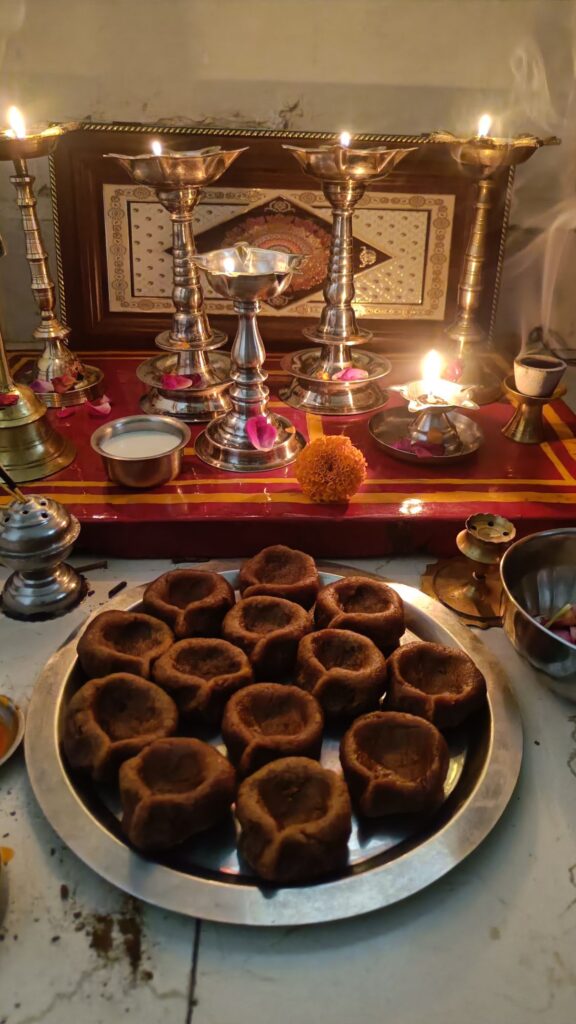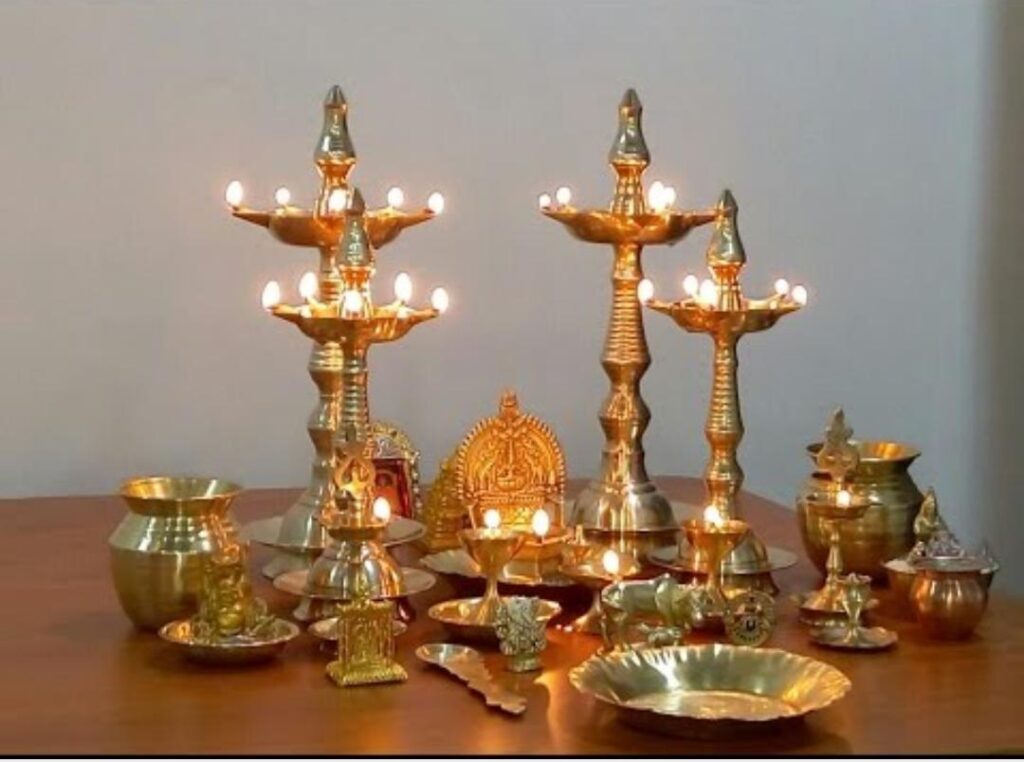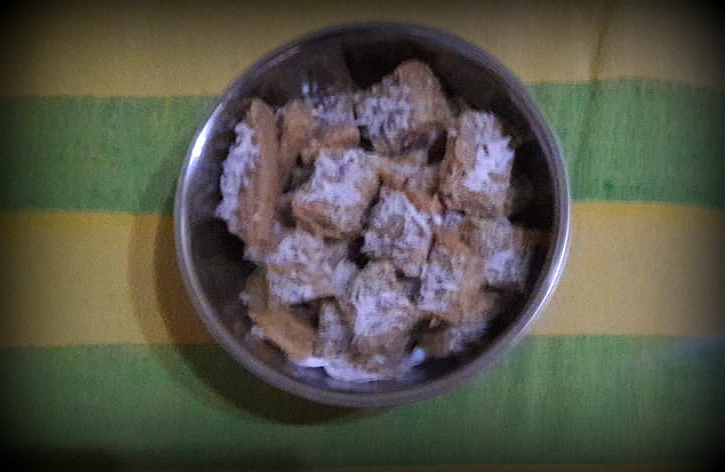Deep Amavasya दीप अमावस्या

Deep Amavasya, also known as Deepa Pujan or Deep Amavas, is a Hindu festival celebrated primarily in Maharashtra, Karnataka, and some parts of India. It falls on the Amavasya (new moon day) of the Hindu month of Ashadha (June-July)/. The festival is significant as it marks the worship of oil lamps (Diya) and signifies the dispelling of darkness and ignorance through the light of knowledge and spirituality. It is considered a very auspicious day. It marks the beginning of Shravan month. This is celebrated in Maharashtra, Gujrat, Andhra, etc.

Key Rituals and Traditions:
Worship of Diyas (Oil Lamps):
Devotees clean and decorate their homes, paying special attention to oil lamps. These lamps, considered symbols of prosperity, are worshipped with devotion. All the Diyas in the house are cleaned and decorated, and puja is performed for them. Diyas of various sizes and shapes are arranged and lit as part of the rituals.Home Decoration:
Homes are beautifully decorated, often with rangoli and flowers, and the lamps are placed at the entrance, windows, and balconies to bring in good energy and ward off negative influences.Offering Prayers:
A small puja is performed in which people worship the oil lamps and sometimes also the household tools, signifying the importance of light and knowledge in daily life. Offerings like flowers, kumkum (vermilion), turmeric, and rice are made, and traditional bhajans or devotional songs are sung.Significance of Light:
The lighting of lamps symbolizes the removal of negative energies and the onset of positivity. The light is seen as a metaphor for knowledge, which dispels ignorance, similar to how light dispels darkness.Family Bonding:
Deep Amavasya is a festival that fosters togetherness, as families come together to perform rituals and celebrate the victory of light over darkness.
In many places, this day is considered auspicious for starting new ventures, as it is believed to bring good fortune. Diya is considered like the Sun, the god of light, God of fire, so we pray Diyas hoping, that they keep lighting our life and bless us.
On Deep Amavasya, we light various lamps, including samai (brass lamp) and clay diyas. Traditionally, they are lit with sesame (til) oil, mustard oil, or even fragrant oils for the deep pujan. After lighting, we shower flowers over the diyas as an offering. The flame symbolizes blessings in our lives, representing Agni, one of the powerful elements of the panchtatva.
इस त्योहार में घर के सभी दीपों को धोकर उनका पूजन किया जाता है । दीप हमारे जीवन का अंधकार दूर कर हमें प्रकाश देते हैं । उनके प्रति कृतज्ञता व्यक्त करने का यह दिन होता है ।
Significance of Lighting Lamps:
This festival is a day to clean and worship all the lamps in the house. The diyas are considered to dispel darkness from our lives, bringing light and clarity. The day is also a way to express gratitude towards them for illuminating our paths. In Hindu tradition, light is a symbol of auspiciousness, prosperity, and abundance. It brings brightness into our lives, helping us see things more clearly, and marks the arrival of the holy month of Shravan.

We extend wishes for happiness and energy to everyone on this day. Every evening, we chant a Marathi shloka that prays to the lamp:
Marathi Shloka:
शुभं करोति कल्याणं आरोग्यं धनसंपदः ।
शत्रुबुद्धिविनाशाय दीपज्योतिनमोऽस्तु ते ॥
This shloka means that we fold our hands and pray to the light of the diya, asking for blessings of prosperity, auspiciousness, good health, wealth, and clarity of thoughts. In our family, it has become a daily ritual to gather every evening and recite this together, reinforcing our prayers.
Additionally, here’s another beautiful Marathi verse dedicated to the diya:
Marathi Verse:
दिव्या दिव्या दिपोत्कार कानीं कुंडलें मोतीहार |
दिव्यला देखून नमस्कार || १ ||
तिळाचे तेल कापसाची वात |
दिवा जळो मध्यान्हरात |
दिवा लावला देवांपाशी |
उजेड पडला तुळशीपाशीं |
माझा नमस्कार सर्व देवांपाशी || २ ||
Divya divya Deepak kaa, Kani kundala moti haa, Divyala pahun namaskar
Diva jalato deva pashi, Ujed padala tulshi pasha,
Maza namaskaar Sarva devanchya paya pasha
Translation:
“I bow to this lamp, I light it in front of God, whose light extends to the tulsi (basil) plant. May my prayers reach all the Gods. The sesame oil and cotton wick keep the lamp burning until the middle of the night.”
In some traditions, we also prepare gur diyas (jaggery lamps) as prasadam. With this, I wish everyone a blessed and joyous Deep Pujan.

हे आहे माझे सण – या शीर्षकांतर्गत मी माझ्या वैयक्तिक अनुभवांमधून सणांना खास प्रकारे मांडते. जर तुम्हाला The Tatwa Girl वर इतर सण आणि परंपरांबद्दल अधिक जाणून घ्यायचे असेल, तर पंचतत्वांतील वायु (AIR) या शीर्षकावर क्लिक करा.
Prachi The Tatwa Girl
#TheTatwaGirl
The Tatwa Girl चे इतर विषयांवरील लेख वाचण्यासाठी खालील पंचतत्वांवर क्लिक करा:
मी पंचतत्वांवरील सर्व घटकांवर लेख लिहिते, जसे की:
- Fire – अग्नी या तत्वाच्या अंतर्गत मी अन्नाशी संबंधित लेख लिहिते. या तत्वाची ऊर्जा आणि जीवनशक्तीने प्रेरित काही खास रेसिपी आणि पाककृती मी येथे शेअर करते.
- Sky – आकाश या तत्वाच्या अंतर्गत मी माझ्या प्रवासाच्या अनुभवांबद्दल लिहिते. या शीर्षकाखाली मी प्रवासादरम्यान अनुभवलेल्या अनंत आकाशाचे आणि उंच पर्वतशिखरांचे वर्णन करते.
- Earth – पृथ्वी या तत्वात, मी आपल्या पृथ्वीशी संबंधित पर्यावरणीय समस्यांवर आणि पर्यावरणपूरक जीवनशैलीच्या उपायांवर लिहिते. आपल्या ग्रहाशी समतोल साधून कसे राहता येईल, हे यात सामावले आहे.
- Water – पाणी या तत्वात, मी माझ्या अंतर्मनातील भावना, त्या प्रवाही आणि अखंडपणे प्रवास करणाऱ्या पाण्याप्रमाणे व्यक्त करते. ही माझ्या विचारांची सातत्यपूर्ण प्रवाहाची अभिव्यक्ती आहे.
- ग्रीन टॉक्स या शीर्षकाच्या अंतर्गत, तुम्ही माझ्या वेबसाइटवर शाश्वत जीवन जगण्याच्या पद्धती शिकू शकता. आजच्या काळात शाश्वत विकास ही एक गरज बनली आहे. Green Tatwa Talks चा पॉडकास्ट नक्की ऐका, जिथे माझ्यासोबत असे अनेक लोक, सदस्य, आणि संस्थांची माहिती दिली जाते, जे पर्यावरणाच्या रक्षणासाठी विशेषतः कार्यरत आहेत आणि सकारात्मक बदल घडवण्यासाठी प्रयत्नशील आहेत.








Those are so cute prasadams – diya shaped. We have so many festivals and so many different rituals. It’s all so good in its own right….
yes you are right that’s the beauty of Incredible India
Deep Amawasya is not celebrated here in Jaipur. This is first time I have heard about it.
It’s just a way to pray for light & diyas that spread light in our life.